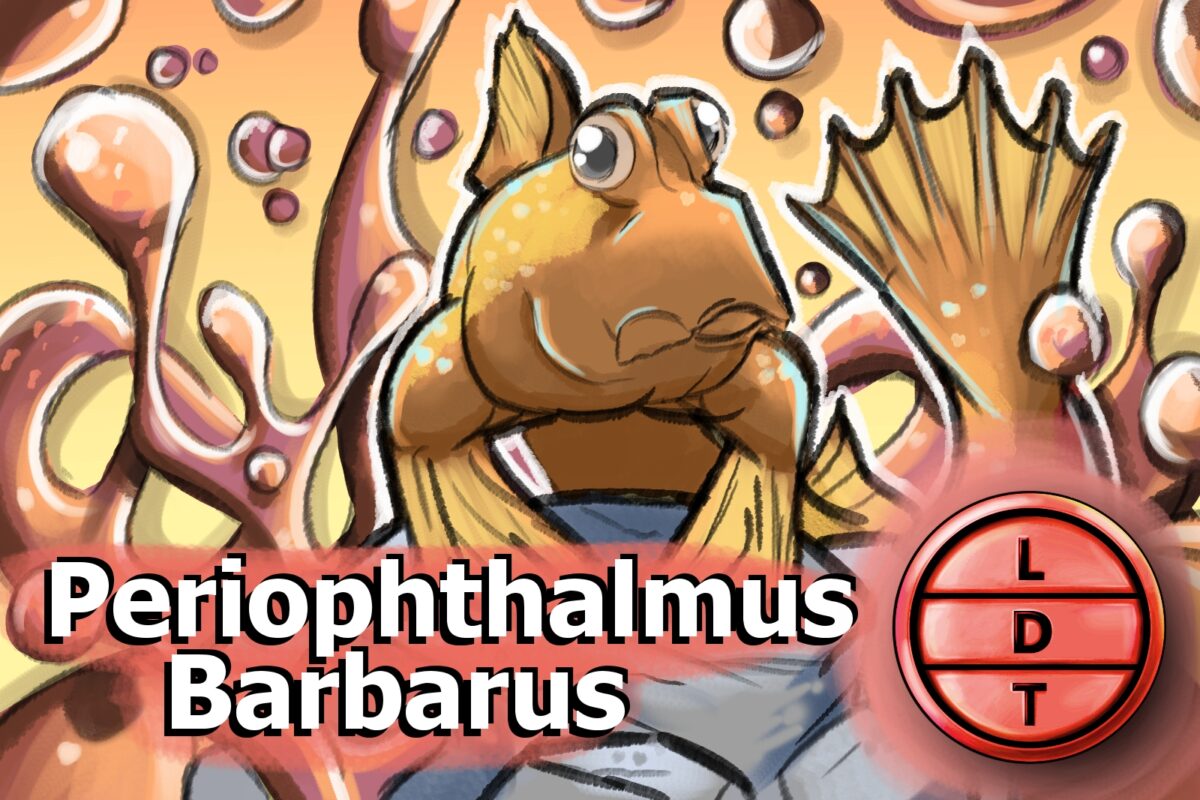“…and today we’re talking about slimy yet satisfying frogish fish, but more on that later.”
While other fish are relegated to the vast oceans, lakes, and rivers that cover 70% of the planet, some decided that it wasn’t enough room. Bent on total global domination, the Atlantic Mudskipper wants to be where the people are. By using its mighty pecs to drag itself onto land, the skipper slaps its way out of the waves and into our hearts as one of the only voluntary fish out of water here in Life, Death, and Taxonomy.
Description
- The mudskipper has a froggish face and a body that tapers down to the tail.
- Mudskippers have bulging frog-like eyes on the tops of their heads.
- They have a large dorsal fin that’s followed by a smaller fin ray.
- They also have small but strong pectoral fins.
- Mudskippers come in a modelled brown in varying shades. They also have black or white specks all over their backs.
Measure Up
Welcome to the beloved Measure Up segment. The official listener’s favorite part of the show! The part of the show when we present the animal’s size and dimension in relatable terms through a quiz that’s fun for the whole family. It’s also the part of the show that’s introduced by you when you send in audio of yourself saying, singing, or chittering the words Measure Up into ldtaxonomy at gmail dot com. We don’t have a new Measure Up intro!
- Snow leopard
- Coyote
- Impala
- Binturong
Length
- 16 cm (6.3 in)
- How many mudskippers go into the length of the Kwanza River in Angola?
- Hint: In 2016, Oscar Scafidi and Alfred Weston achieved the world record fastest time to travel the length of the river in a kayak, which took 32 days 12 hours.
- 6,034,285.71 Mudskippers. The river is about 600 miles (960 km) long.
Weight
- 0.5 to 65.3 grams
- How many mudskippers go into the weight of the volume of diamonds produced by Angola in 2019?
- Hint: Angola is rich in natural resources like diamonds and oil, but it’s also one of the worst places in the world for malnutrition. They had a childhood mortality rate of 74.7 deaths per 1,000 live births in 2019. The world average is 38 per 1,000. Part of the reason for this disparity is deep government corruption.
- 27,871.4 mudskippers. 9.1 million carats.
Fast Facts
Mudskippers are native to West Africa in countries like Angola, Democratic Republic of the Congo, Cameroon and Ghana.
Mudskippers enjoy mangrove swamps and tidal flats.
They are able to hibernate in burrows during cold seasons. Sometimes their burrows can get low on oxygen and the fish will gulp fresh air and replace the air in their burrows.
These frog fish are carnivorous and enjoy the way of the ambush predator. Like other fish, they use the move “hydrodynamic tongue,” which is using water suction to pull prey into their mouths. If done right no can defend.
They’re able to retain moisture with mucus that covers their body.
Major Fact: A Fish Out of Water
This is a phrase typically for being out of your element, but for most fish it means “soon to be dead.” But the mudskipper is very good at not being dead when out of the water.
In fact, it regularly lugs its tiny body out of the water and onto the mud to find food and muddier pastures. They actually spend the majority of their days on land.
But don’t fish have gills that can only get oxygen out of water? Wouldn’t they flop pathetically to their deaths?
Well, yes it has gills, and it does need water in order to breathe – so it can’t really dry out.
But it has the ability to close its gill chambers and trap water inside for convenient breathing on the go.
So before going to work in the morning, the mudskipper will pack a lunch of breathing juice. But it also has another ability called “cutaneous respiration”, which basically means that it can breathe through its skin.
While it spends most of its day on land, that land isn’t the gobi desert. It is almost always skipping across very moist surfaces like moss, mangrove roots, and, you guessed it, mud. So it can always either do a good bit of skin breathing when it needs to or replenish its breathing juice.
Lastly, it can also gulp air into its mouth, which is lined with blood vessels set close to the surface of the skin and easily absorb oxygen.
So it can breathe on land because of its hole control and special skin, but how can it move around? Don’t fish tend to flop helplessly?
Yes, but these don’t.
Thanks to a pair of specialized pectoral fins (the ones on the fish’s sides) as well as another pair of pelvic fins (near the fish n’ hips) it can move on land.
The pectoral fins are actually fused together, which creates a kind of suction cup that allows the mudskipper to climb up rocks – like other gobi fish.
It kind of moves like a chimpanzee by placing its tiny pelvic cups on the ground, bringing its longer pecs around and swinging its body forward.
It can also use its tail to book it if need be, which also helps it jump.
Ending: So gulp some air, get out of your comfort zone, and work out your pecs like the mudskipper here in Life, Death, and Taxonomy.

